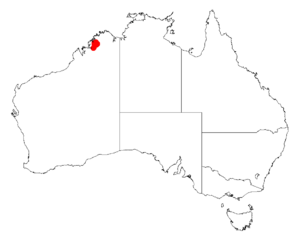Ring-pod minni-ritchie facts for kids
Quick facts for kids Ring-pod minni-ritchie |
|
|---|---|
| Conservation status | |
| Scientific classification | |
| Genus: |
Acacia
|
| Species: |
cyclocarpa
|
 |
|
| Occurrence data from AVH | |
Acacia cyclocarpa, also known as the ring-pod minni-ritchie, is a type of shrub. It belongs to the Acacia family, which is famous for its many different species. This plant naturally grows in a small part of the Kimberley area in Western Australia.
What the Ring-Pod Minni-Ritchie Looks Like
This shrub can grow in different ways. It might spread out low to the ground, or stand partly upright. It usually reaches a height of about 0.6 to 1 meter (2 to 3 feet). Older parts of its stems have bark that looks like "minni ritchie" bark.
Its small branches are smooth, meaning they have no hairs. These branches have tiny, triangle-shaped parts called stipules, which are about 1 millimeter long. Like most Acacia plants, it has special leaf-like structures called phyllodes instead of true leaves.
These phyllodes are always green and feel thin. They are long and narrow, like a line or a slim oval. They get narrower at their base. Each phyllode is about 4 to 8.5 centimeters (1.5 to 3.3 inches) long and 1 to 2.5 millimeters wide. They have a fine, curved tip that is not sharp or harmful.
Where the Ring-Pod Minni-Ritchie Grows
The ring-pod minni-ritchie is found only in a specific area. It grows naturally in the northwestern part of Western Australia, in the Kimberley region. You can find it especially in the area around the Prince Regent River.
There are quite a few of these plants in this region. They grow in sandy soils that are thin, often over broken sandstone rocks. These plants are spread out over several kilometers. They live in scrubland areas with other plants like Acacia orthocarpa, Eucalyptus miniata, Eucalyptus phoenicea, Owenia vernicosa, and Triodia claytonii.


